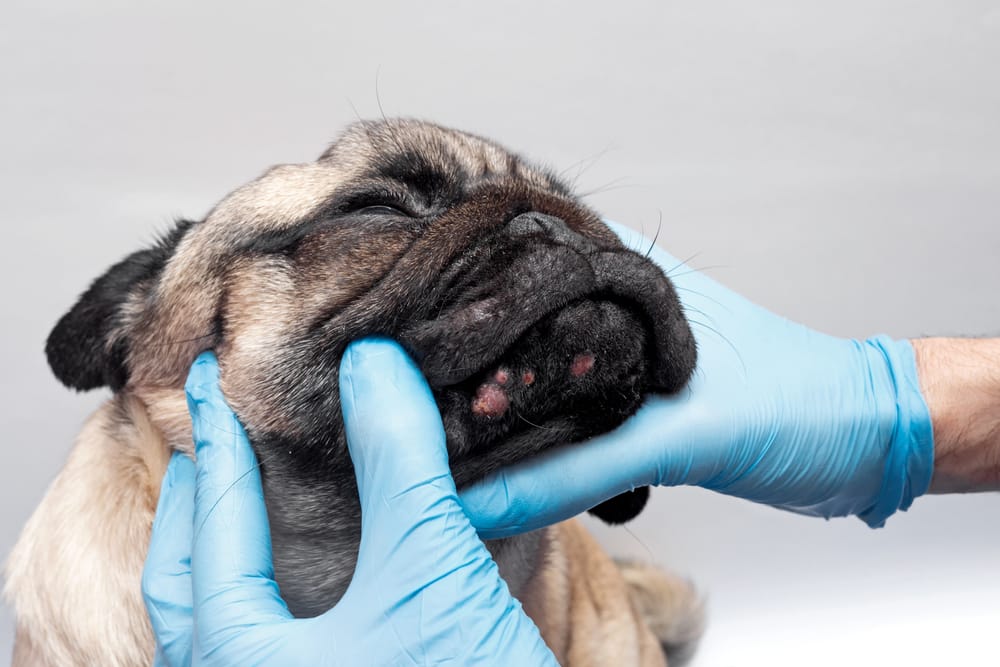Just like humans, our pets can also be victims of different types of allergies. Skin allergies in dogs in particular can cause discomfort and distress. One common question pet owners ask is whether dogs can get eczema. While the term “eczema” is primarily used in human medicine, dogs can indeed develop similar inflammatory skin conditions, most commonly known as atopic dermatitis.
Understanding skin allergies in dogs is crucial for prompt diagnosis and effective treatment. These conditions affect countless dogs worldwide and can significantly impact their quality of life if left untreated. Let’s explore what canine eczema is, how it manifests, and what you can do to help your furry friend find relief.
What is canine eczema?
Canine eczema, more accurately referred to as atopic dermatitis in veterinary medicine, is a chronic, inflammatory skin condition caused by allergic reactions to environmental substances. This condition occurs when a dog’s immune system overreacts to certain allergens, resulting in skin inflammation and intense itching.
Atopic dermatitis is one of the most common forms of skin allergies in dogs and tends to be genetic in nature, with certain breeds showing a higher predisposition to developing this condition. The hypersensitivity reaction leads to a breakdown in the skin’s natural barrier function, making it more susceptible to irritation and secondary infections.
8 Common Symptoms of Eczema in Dogs
- Persistent itching and scratching – Dogs with atopic dermatitis typically show intense itching (pruritus) and skin irritation, which is often the first and most noticeable sign of the condition.
- Redness and inflammation – Affected areas of skin become red, inflamed, and may feel warm to the touch due to the allergic reaction.
- Hot spots – These are localized areas of acute moist dermatitis that develop rapidly, appearing as red, moist, painful lesions where the dog has been excessively licking or scratching.
- Dry, flaky skin – Dry and scaly skin with visible dandruff in the coat is a common sign of allergies in dogs.
- Hair loss – Constant scratching and inflammation due to itchy skin can lead to patches of hair loss around affected areas.
- Skin thickening – Chronic inflammation can cause the skin to become thickened and leathery in texture, a condition known as lichenification.
- Ear infections – Skin allergies in dogs can also cause recurrent ear infections, particularly in breeds with floppy ears.
- Paw licking and chewing – Excessive attention to the paws, including frequent licking and chewing, is common in dogs with atopic dermatitis.
3 Other Types of Skin Allergies in Dogs and Their Specific Triggers
Flea Allergy Dermatitis (FAD)
Flea allergy dermatitis is the most common skin allergy in dogs and occurs when dogs develop hypersensitivity to proteins in flea saliva. When a flea bites an allergic dog, it triggers an intense immune response that causes severe itching and inflammation. Even a single flea bite can cause a severe reaction in susceptible dogs, making this condition particularly frustrating for pet owners. The allergic reaction typically leads to intense itching focused primarily on the base of the tail, lower back, and thighs.
Food Allergies
Food allergies in dogs involve an abnormal immune response to certain ingredients in the dog’s diet. Unlike food intolerances, which cause digestive upset, true food allergies manifest primarily as skin problems. Dogs can develop allergies to foods they’ve eaten for years, making diagnosis challenging. Food allergies typically cause year-round symptoms and may be accompanied by gastrointestinal issues in some cases.
5 Common Food Allergens
- Animal proteins – Beef, chicken, dairy, and eggs are among the most common food allergens for dogs.
- Grains – Wheat, corn, and soy can trigger allergic reactions in sensitive dogs.
- Preservatives and additives – Artificial colors, flavors, and preservatives in commercial dog foods may cause reactions in some dogs.
- Novel ingredients – Some dogs may react to exotic proteins like venison or duck, especially if they’ve been previously exposed.
- Treats and table scraps – Human foods and commercial dog treats often contain multiple ingredients that can trigger allergies.
Contact Dermatitis
Contact dermatitis occurs when a dog’s skin comes into direct contact with an irritating or allergenic substance. This condition is less common than other skin allergies in dogs but can cause significant discomfort. The reaction is typically localized to areas that have directly touched the offending substance, such as the paws, belly, or muzzle, depending on the source of exposure.
4 Common Allergens
- Household chemicals – Cleaning products, laundry detergents, and floor cleaners can irritate sensitive skin.
- Lawn and garden treatments – Fertilizers, pesticides, and herbicides may cause reactions in dogs who walk on treated surfaces.
- Plants – Certain plants like poison ivy, poison oak, or stinging nettles can cause contact reactions.
- Fabrics and materials – Some dogs react to synthetic materials in bedding, collars, or clothing.
How are skin allergies in dogs treated?
Antihistamines and Anti-inflammatory Medications
Antihistamines and anti-inflammatory medications are often first-line treatments for managing skin allergies in dogs. These medications work by blocking histamine receptors or reducing inflammation, helping to alleviate itching and calm allergic reactions.
While over-the-counter antihistamines like diphenhydramine (Benadryl) are sometimes used, prescription medications are often more effective for severe allergic reactions. Your veterinarian may prescribe corticosteroids for short-term relief of intense itching, though these should be used cautiously due to potential side effects with long-term use.
Immunotherapy
Immunotherapy is a specialized treatment option for dogs with confirmed environmental allergies. This approach involves gradually exposing the dog to small, increasing amounts of identified allergens to desensitize their immune system over time. Traditionally administered as allergy shots (subcutaneous immunotherapy), newer options include sublingual immunotherapy delivered as oral drops.
Immunotherapy is typically recommended for dogs with year-round or severe seasonal allergies that haven’t responded well to other treatments. This is because the treatment takes a longer time before seeing results. The treatment can take 6-12 months but it offers the possibility of long-term allergy control rather than symptom management.
Topical Treatments
Topical treatments provide direct relief to affected skin areas and are an important component of managing skin allergies in dogs. These include medicated shampoos, conditioners, sprays, and ointments formulated specifically for canine skin conditions.
Many contain ingredients like hydrocortisone, oatmeal, or aloe vera to soothe inflammation and relieve itching. Antimicrobial formulations may be recommended if secondary skin infections are present. Regular medicated baths can help remove allergens from the coat, strengthen the skin barrier, and provide temporary relief from itching.
Dietary Management
Dietary management plays a crucial role in treating food-related skin allergies in dogs and can also support skin health in dogs with other types of allergies. For dogs with confirmed or suspected food allergies, an elimination diet using novel protein and carbohydrate sources or hydrolyzed protein diets may be recommended. These specialized diets must be strictly followed for 8-12 weeks, avoiding all treats and supplements that could contain allergens.
Once improvement is seen, controlled food challenges help identify specific trigger ingredients to avoid in the future. Additionally, omega-3 fatty acid supplements are often recommended for treating skin allergies in dogs, as they have natural anti-inflammatory properties that support healthy skin and coat.
Medications for Severe Cases
For severe or recurrent skin allergies in dogs, newer prescription medications offer targeted approaches to controlling symptoms. Medications like oclacitinib (Apoquel) work by inhibiting specific inflammatory pathways involved in itching, providing rapid relief with fewer side effects than traditional corticosteroids.
Another option is lokivetmab (Cytopoint), a monoclonal antibody therapy that targets and neutralizes a specific protein involved in the itch signal. Given as an injection every 4-8 weeks, it can provide extended relief without daily medication. These newer options have revolutionized treatment for skin allergies in dogs, though they require veterinary prescription and monitoring.
8 Tips for Preventing Skin Allergies in Dogs
- Regular bathing and grooming – Bathe your dog with hypoallergenic shampoos to remove environmental allergens from their coat and skin. Regular brushing also helps remove allergens before they can cause irritation.
- Flea prevention – Maintain year-round flea control using veterinarian-recommended products, even if you don’t see fleas on your dog. For dogs with flea allergy dermatitis, even a single flea bite can trigger a severe reaction.
- Environmental control – Reduce exposure to environmental allergens by regularly vacuuming your home with a HEPA filter vacuum, using air purifiers, and washing your dog’s bedding weekly in hot water.
- Dietary management – Feed a high-quality, balanced diet appropriate for your dog’s specific needs. If food allergies are suspected, work with your veterinarian to identify and eliminate problematic ingredients.
- Protective clothing – Consider using protective clothing like boots during walks to minimize contact with potential allergens like grass, pollen, or treated lawns.
- Limited exposure during high pollen seasons – Walk your dog during times when pollen counts are lower, typically early morning or evening, and wipe down their coat and paws when returning from outdoors.
- Regular veterinary check-ups – Schedule routine examinations to catch skin problems early before they become severe chronic conditions. Early intervention often leads to more successful outcomes.
- Stress reduction – Minimize stress in your dog’s environment, as stress can exacerbate allergic reactions and increase itching behaviors through a complex relationship between the nervous and immune systems.
Conclusion
Skin allergies in dogs, including canine eczema or atopic dermatitis, are manageable conditions that require proper diagnosis and consistent treatment. By understanding the triggers, recognizing early symptoms, and following your veterinarian’s treatment plan, you can help your dog find relief from the discomfort of allergic skin conditions.
If you notice signs of skin allergies in dogs, don’t wait until the condition worsens. Contact Symphony Mobile Veterinary Clinic today to schedule an appointment for a comprehensive evaluation. Our experienced team specializes in diagnosing and treating skin conditions to keep your pet comfortable and healthy. Follow us on Facebook, X, Instagram, YouTube, and LinkedIn for more helpful information about caring for your beloved pets.



